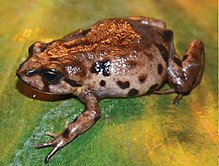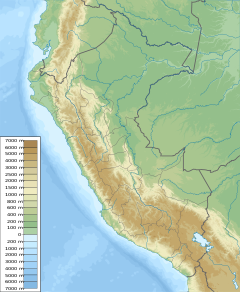
Phrynopus is a genus of frogs of the family Strabomantidae. Their common name is Andes frogs. They are endemic to Peru and inhabit the upper humid montane forest and supra-treeline grassland in the Cordillera Oriental, with one record from the Peruvian Cordillera Occidental.

Allobates ornatus is a species of frog in the family Aromobatidae. It is endemic to northern Peru where it is only known from near its type locality, Tarapoto in the San Martín Province, on the eastern slopes of the Cordillera Oriental.
Oreobates lundbergi is a species of frogs in the family Strabomantidae. It is endemic to central Peru and is known from the Amazonian slopes of the Cordillera Oriental in the Paucartambo District, Pasco.
Pristimantis rufioculis is a species of frog in the family Strabomantidae. It is found in the Andes of northern Peru and adjacent Ecuador (Zamora-Chinchipe). The specific name rufioculis is derived from the Latin words rufiis, meaning red, and oculis, meaning eye—red iris is one of the distinguishing characteristics of this species. Accordingly, common name red-eyed robber frog has been proposed for this species.
Pristimantis shrevei is a species of frog in the family Strabomantidae. It is endemic to Saint Vincent, the West Indies. Its common name is Saint Vincent frog.
Gastrotheca atympana is a species of frog in the family Hemiphractidae. It is endemic to Peru and only known from its type locality in the Pampa Hermosa National Sanctuary, Junín Region. It lacks an external tympanum, hence the specific name atympana.
Phrynopus bracki is a species of frog in the family Strabomantidae. It is endemic to Peru and only known from its type locality in the Cordillera Yanachaga, Pasco Region. The specific name bracki honors Antonio Brack, agronomist and ecologist who was instrumental for the establishment of the Yanachaga–Chemillén National Park. Common name Brack's Andes frog, has been coined for it.
Phrynopus dagmarae is a species of frog in the family Strabomantidae. It is endemic to the Andes of Peru and only known from the Pachitea and Ambo Provinces in the Huánuco Region, from near the type locality. The specific name dagmarae honors Dagmar Schramm from Germany.

Phrynopus kauneorum is a species of frogs in the family Strabomantidae. It is endemic to the Andes of Peru and known from near its type locality in the Pachitea Province, as well as from the Cordillera de Carpish, both in the Huánuco Region. The specific name kauneorum honors Andreas, Meeta, and Rebekka Kaune from Germany.
Niceforonia lucida is a species of frog in the family Strabomantidae. It is endemic to Peru and known from the Cordillera Central west of the Apurímac River in the Ayacucho Region. Common name Cannatella's Andes frog has been coined for it. The specific name lucida refers to distinctive coloration of this frog relative to frogs in the genus Phrynopus, the genus where this species was initially placed. However, later studies have moved it to other genera where its colors are less distinctive.
Phrynopus montium is a species of frog in the family Strabomantidae. It is endemic to Peru and only known from two localities near Cascas in the Junín Region: "Cascas near Huasahuasi", the imprecisely known type locality where the types were collected in 1936, and south of Hacienda Cascas, where it was found in 2014. Records from the PascoPasco and Huánuco Regions refer to Phrynopus kotosh and Phrynopus oblivius, respectively. Common name Cascas Andes frog has been coined for this species.
Lynchius nebulanastes is a species of frog in the family Strabomantidae. It is endemic to north-western Peru where it is known from the vicinity of its type locality, El Tambo, on the western slope of the Cordillera de Huancabamba, Piura Region. Common name Canchaque Andes frog has been coined for it.
Oreobates pereger, also known as the Ayacucho Andes frog, is a species of frog in the family Strabomantidae. It is endemic to Peru where it is known from the eastern slopes of the Cordillera Oriental and Cordillera Vilcabamba mountain ranges.
Telmatobius ignavus is a species of frog in the family Telmatobiidae. It is endemic to the Cordillera de Huancabamba in the Department of Piura, Peru. Common name Piura water frog has been coined for it.
Phrynopus tribulosus is a species of frog in the family Strabomantidae. It is endemic to Peru and only known from its type locality near Oxapampa at 2,600 m (8,500 ft) asl, and from Santa Bárbara, in the Huancabamba District, Oxapampa, Pasco Region. It inhabits humid montane forests where individuals could be found deep within a mossy bank by day.
Phrynopus oblivius is a species of frog in the family Strabomantidae. It is endemic to central Peru and only known from near its type locality near Maraynioc, in the Tarma Province, Junín Region, at about 3,210–3,220 m (10,530–10,560 ft) asl. It is known from a collection in 2005; there has been no later surveys for the species.

Noblella madreselva is a species of frog in the family Strabomantidae. The species is only known from its type locality, Madre Selva in the La Convención Province, Cusco, Peru.

Pristimantis attenboroughi, also known as Attenborough's rubber frog, is a species of frog in the family Strabomantidae. It is endemic to the Peruvian Andes and has been recorded in and near the Pui–Pui Protection Forest. It is the first amphibian named after David Attenborough. It was discovered by Edgar Lehr and Rudolf von May during a period of two years of studying the forests of Peru. The species description was based on 34 specimens caught at elevations of 3,400–3,936 m (11,155–12,913 ft) above sea level.

Psychrophrynella chirihampatu is a species of frogs in the family Strabomantidae. It is endemic to Peru and known only from its type locality, the Japumato Valley in the Peruvian Andes of the Cusco. The common name Japumayo Andes frog has been coined for this species.

Pristimantis ashaninka is a species of frog in the Craugastoridae family. It is found in the Pui Pui Protection Forest in central Peru. It is 23 to 26 millimeters long, and is characterized by containing small conical tubercles in its skin, giving a spiny appearance, and by having no tympanic membrane. The species was described in 2017 after morphological and genetic analyses and was named Pristimantis ashaninka in honor of the indigenous people Asháninka, who live in the regions near the protection forest. The species was listed by the International Union for Conservation of Nature as a least-concern species. There is still no information about its behavior and/or reproduction, but it is assumed that the tadpoles have direct development, as this is a common characteristic of the genus.









